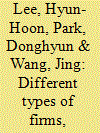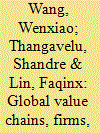|
|
|
Sort Order |
|
|
|
Items / Page
|
|
|
|
|
|
|
| Srl | Item |
| 1 |
ID:
120623


|
|
|
|
|
| Publication |
2013.
|
| Summary/Abstract |
Using highly disaggregated HS 8-digit product-category level data collected by the Chinese Customs Office for 2000 and 2008, we perform an in-depth anatomy of China's imports of manufactured goods. We estimate both the extensive margins - number of products imported per product group or trade partner - and intensive margins - amount of imports per product group or trade partner - of China's imports. Our paper contributes to the literature of firm heterogeneity in international trade in three different ways. First, we distinguish firms into foreign firms and domestic firms, which are further divided into private firms and public firms. Second, we distinguish products into final goods and intermediate goods. Third, we estimate gravity equations from the perspective of dynamics utilizing a dynamic adjustment model. Overall, our analysis yields a number of new stylized facts about China's imports. These, in turn, help us to gain a fuller understanding of China's trade patterns in light of its recent emergence as a globally significant importer.
|
|
|
|
|
|
|
|
|
|
|
|
|
|
|
|
| 2 |
ID:
182727


|
|
|
|
|
| Summary/Abstract |
How does participating or moving to more upstream in the global value chains (GVCs) affect the premium paid to skilled compared to unskilled labor within firms? In this paper, we develop a model of heterogeneous firms with intermediate trade and two skill inputs, in which we apply the fair wage hypothesis to predict the wage premium changes according to firms' GVCs activities. The model predicts that firms' backward GVC participation, as measured by the share of foreign value-added content in exports (FVAR), has an ambiguous impact on wage inequality of skills, which depends on the relative importance of “FVAR-labor substitution effect” and “FVAR-profit effect.” However, moving to upstream sectors in GVCs, as measured by the export varieties' upstreamness (or average distance from final use), raises a firm's wage premium. Using detailed Chinese firm-level data from 2000 to 2006, we develop a Mincer-type empirical model to study the wage premium changes associated with FVAR and upstreamness. We find robust empirical evidence that the rise of wage inequality in China mainly arises from moving to more upstream sectors rather than changing GVC participation.
|
|
|
|
|
|
|
|
|
|
|
|
|
|
|
|
| 3 |
ID:
175576


|
|
|
|
|
| Summary/Abstract |
The development of information and communications technology (ICT), particularly the Internet, has reduced trade costs. However, it remains unclear whether these reduced costs are reflected in the “extensive margins” of firms’ exports (which refer to the probability of firms exporting) or the “intensive margins” (which refer to the value of firms’ export). To test this, we used the concepts of information cost and binary margins, an augmented trade model of firm heterogeneity, a two‐stage Heckman estimation, and data from the World Bank Enterprise Survey of Chinese firms in 2012. The results revealed that reduced trade costs from the use of ICT were positively related to extensive margins but that the connection with intensive margins was not significant. The results lead to the conclusion that reduced information costs related to a firm's exporting behavior were primarily reflected in variable trade costs. This study offers theoretical and empirical evidence for China's policies towards the Internet, which are relevant for the export of manufactured goods. The government should encourage the use of ICT to enhance firms’ export opportunities while facing current trade policy uncertainty.
|
|
|
|
|
|
|
|
|
|
|
|
|
|
|
|
| 4 |
ID:
172372


|
|
|
|
|
| Summary/Abstract |
This paper examines the impact of currency appreciation and firm heterogeneity on exports from ASEAN, which appears to have the potential to replicate China’s export-driven growth miracle. It tries to fill the gap in literature related to exchange rate fluctuations and firm heterogeneity in Southeast Asia, specifically focusing on the “zero-trade” problem. Four main findings emerge from this study. First, contrary to conventional wisdom, exchange rate appreciation does, in fact, discourage exports by ASEAN-based companies. Second, firm responses to currency appreciation vary significantly. While SMEs and first-time exporters are more sensitive to exchange rate movements, other exporters can mitigate these risks through foreign and domestic affiliations (although foreign ownership proves to be more helpful). Third, firms whose exports consist of foreign inputs are less affected by local currency appreciation. And fourth, companies in the services sector are more sensitive to currency appreciation than those in manufacturing.
|
|
|
|
|
|
|
|
|
|
|
|
|
|
|
|
|
|
|
|
|